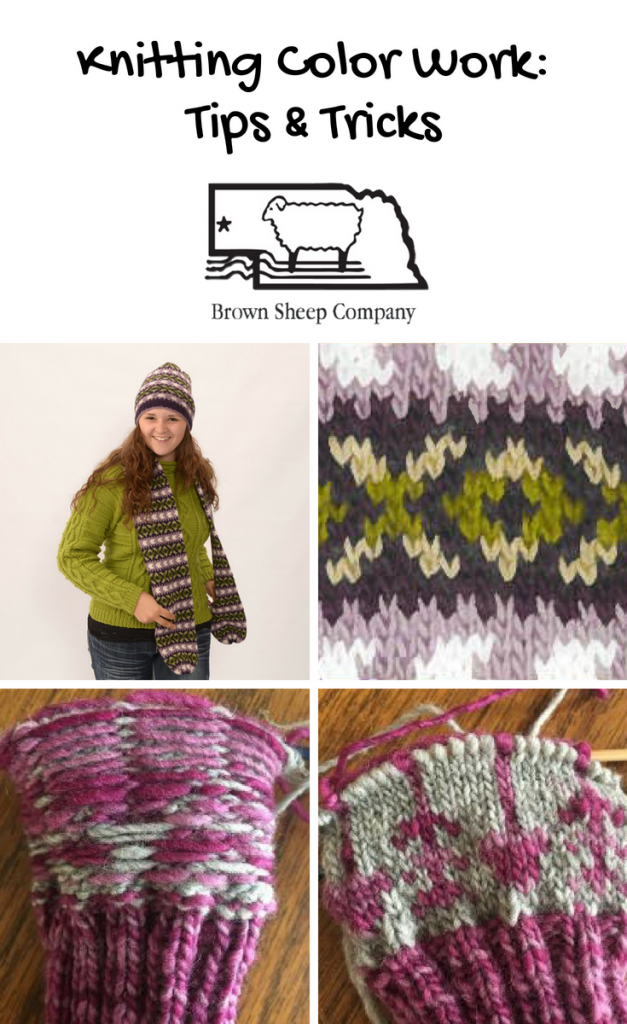Knitting Color Work: Tips & Tricks

Wanting to try stranded color work or Fair Isle knitting, but feeling a little intimidated? We’ve got some handy tips on making this dream a reality.
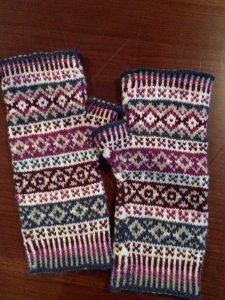
What exactly is color work? Basically, this is multi-colored knitting that’s done by carrying two colors at a time across a row. The pattern can have a million different colors included, but only two are used within a single row. True “Fair Isle” knitting is more specific – originating from the island of its namesake in Shetland, northern Scotland – but generally can be used interchangeably with the term “colorwork”.

First of all: choose the right pattern for learning to knit with two colors at a time. Please, for the sake of your sanity, choose a pattern that’s knit in the round! You want to have the right side facing you at all times rather than messing with purling on the wrong side. Our Jeanette Scarf is a nice choice because it’s knit in a small tube in the round (it’s also available as a free download when you sign up for our newsletter!). Hats or mittens are also great choices.

Next: choose a natural, non-superwash wool yarn. I may seem biased in encouraging you to knit with wool, but seriously — the natural barbs in wool fiber will cling together, helping the stitches to stay in place. Wool will naturally relax into a smooth, even surface after blocking to improve any tight or loose spots in your knitting. Cotton or acrylic blend yarns are not ideal because they are too smooth to cling together properly and don’t have the “memory” that wool does to hold its shape. Most color work patterns use a light to medium weight wool yarn – our Nature Spun Fingering, Nature Spun Sport, Lanaloft Sport, and Prairie Spun DK are ideal for color work projects. See our post on selecting color palettes for color inspiration.
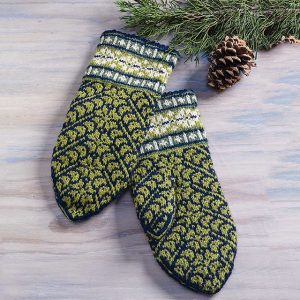
There are a multitude of techniques used to carry two strands of yarn across a row of knitting. Many knitters like to wrap each strand around a different finger and knit all stitches English style (“throwing”) or Continental style (“picking”). If you happen to know both styles of knitting (I do know both because I learned to knit English-style and then “converted” to Continental-style), work one strand in your right hand to “throw” and one strand in your left hand to “pick”. The two-handed method is great because the two yarns do not get tangled. If you are able to take a class on this technique, or self-learn the opposite knitting style from your current preference, I highly recommend giving it a try. With two hands, color work is both addictive and soothing.

Tension is the most difficult aspect to master in color work knitting. Tension will be easiest to tackle if you choose a pattern that doesn’t require long floats. “Floats” are the yarn that’s carried behind the stitches across a row. For example, if there are 3 stitches in a row of one color, the other color will need to be carried behind it for 3 stitches. The unused yarn ends up “floating” behind the pattern. A long float would be considered more than 5 stitches in a row of one color before changing. Floats can get in the way in the finished project because they can snag – and, they can mess with the tension of the knit stitches around them.
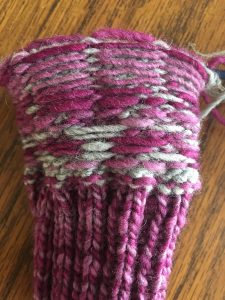 If you do come to a spot where it’s necessary to carry your yarn across more than 5 stitches, remember to “catch your floats” every so often. This means picking up the float in the back of a stitch to hold it in place and keep some tension in the floating yarn so it doesn’t pull too tight or loosen up. Here is a nice tutorial from Jimmy Beans Wool on how to catch floats. Also, if you need to catch floats in a bunch of rows – don’t catch in the same place every row. It’s better to stagger the tension so you don’t end up with one column of stitches pulling towards the inside of the project.
If you do come to a spot where it’s necessary to carry your yarn across more than 5 stitches, remember to “catch your floats” every so often. This means picking up the float in the back of a stitch to hold it in place and keep some tension in the floating yarn so it doesn’t pull too tight or loosen up. Here is a nice tutorial from Jimmy Beans Wool on how to catch floats. Also, if you need to catch floats in a bunch of rows – don’t catch in the same place every row. It’s better to stagger the tension so you don’t end up with one column of stitches pulling towards the inside of the project.
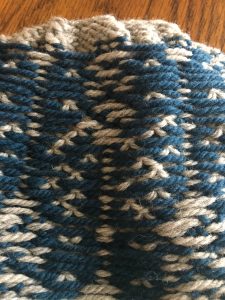 Making mistakes in any technique is inevitable, because we’re all human! The good news is that picking up dropped stitches in color work is actually not hard! If you can pick up a regular knit stitch, then you can definitely pick up and fix a dropped stitch within a section of color work. Simply pick up loose bars of yarn in the order they belong (according to your chart), and you’ll be back in business. Back-knitting is just as easy with two strands of yarn as a single strand. So, don’t let the fear of making mistakes stop you from trying a new technique.
Making mistakes in any technique is inevitable, because we’re all human! The good news is that picking up dropped stitches in color work is actually not hard! If you can pick up a regular knit stitch, then you can definitely pick up and fix a dropped stitch within a section of color work. Simply pick up loose bars of yarn in the order they belong (according to your chart), and you’ll be back in business. Back-knitting is just as easy with two strands of yarn as a single strand. So, don’t let the fear of making mistakes stop you from trying a new technique.
If you’re ready to take the plunge, click here to sign up for our newsletter & we’ll send you a free PDF download of the Jeanette Hat & Scarf Pattern, a lovely colorwork ensemble in which both pieces are knit in the round!
Like this post? Pin it!
